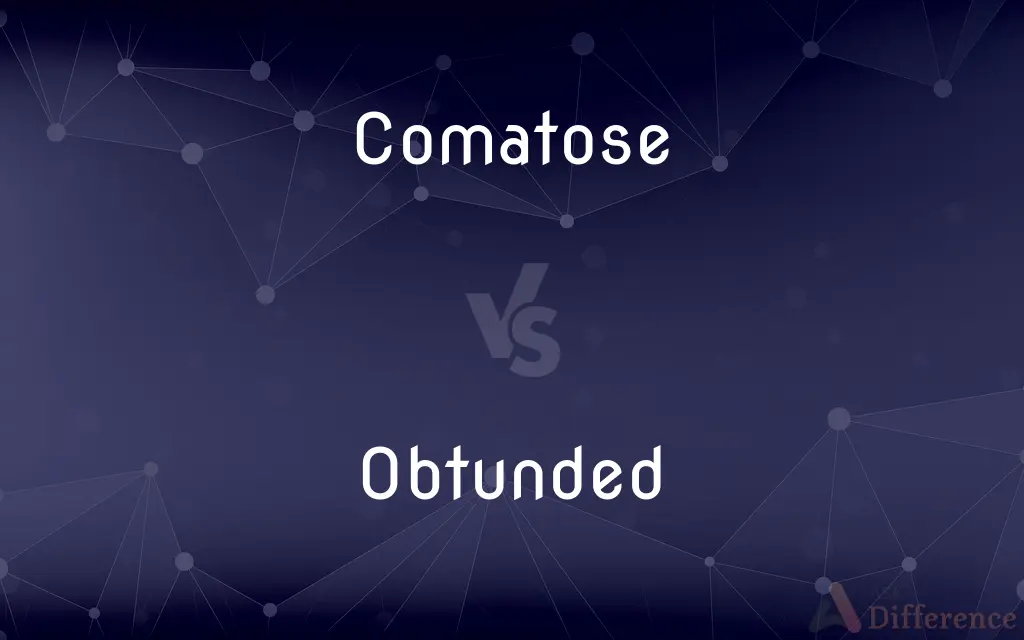Comatose vs. Obtunded — What's the Difference?
By Tayyaba Rehman & Maham Liaqat — Updated on April 22, 2024
Comatose individuals are unresponsive and cannot be awakened, whereas obtunded individuals, though less alert, respond to stimuli.

Difference Between Comatose and Obtunded
Table of Contents
ADVERTISEMENT
Key Differences
Comatose patients exhibit a deep state of unconsciousness and do not respond to any form of stimuli, including pain. On the other hand, obtunded individuals maintain a diminished responsiveness and alertness but can still respond to stimuli to a certain extent.
In a coma, the individual shows no voluntary actions and does not react to the environment, often requiring life support for bodily functions. Whereas, an obtunded person can perform limited voluntary actions and may need minimal assistance for daily activities.
The causes of comatose states can vary from severe brain injuries, drug overdoses, or major medical conditions affecting the brain. In contrast, obtundation might result from less severe but still significant medical conditions, sedation, or psychiatric disorders.
Diagnostic approaches for a comatose patient often involve extensive neurological exams and imaging to assess the extent of brain damage. Conversely, evaluation of an obtunded state might focus more on the underlying cause, such as toxicological screening or infection markers.
Treatment for coma typically involves addressing the root cause, such as surgery for head trauma, alongside supportive care in an intensive care unit. Meanwhile, treatment for obtundation may also include addressing the underlying cause but often involves less intensive supportive care.
ADVERTISEMENT
Comparison Chart
Level of Consciousness
No consciousness, unarousable
Reduced consciousness, less alert
Responsiveness to Stimuli
No response to any stimuli
Limited response to strong stimuli
Voluntary Actions
None
Limited
Typical Causes
Severe brain injury, overdose
Milder injuries, infections
Treatment Approach
Intensive care, address cause
Address underlying cause, support
Compare with Definitions
Comatose
Pertaining to a state of deep unconsciousness from which a person cannot be aroused.
After the car accident, the driver was found comatose.
Obtunded
Describes a state of reduced alertness and responsiveness.
The medication left her obtunded and disoriented.
Comatose
Resulting from or related to a coma.
The patient displayed comatose reflexes during the examination.
Obtunded
Pertaining to dulled or lessened sensitivity.
He was obtunded to the pain due to the analgesics.
Comatose
Characterized by a lack of response to external stimuli.
The comatose patient did not react to the light shone in his eyes.
Obtunded
Characterized by a blunted affect or reduced cognitive function.
The elderly man was obtunded, responding slowly to questions.
Comatose
Relating to a state requiring medical intervention to maintain bodily functions.
Comatose patients often require ventilatory support.
Obtunded
Used to describe a moderate decrease in a patient’s wakefulness.
Post-surgery, patients often remain obtunded for several hours.
Comatose
Used metaphorically to describe extreme lethargy or unresponsiveness.
The audience was comatose after the long lecture.
Obtunded
Related to a medical condition causing diminished consciousness.
The obtunded patient was monitored for any sign of improvement.
Comatose
Of, relating to, or affected with coma; unconscious.
Obtunded
To make less intense; dull or deaden.
Comatose
Marked by lethargy; torpid.
Obtunded
Simple past tense and past participle of obtund
Comatose
In a coma: unconscious.
The patient was comatose for 2 weeks before finally passing away.
Obtunded
(medicine) Far from alert or oriented to time and space, and exhibiting other signs of being confused, a state just short of frank delirium.
Comatose
(informal) Drowsy or lethargic.
Comatose
(informal) Fast asleep.
She was lying comatose on the sofa.
Comatose
To make comatose; to send into, or as if into, a coma.
Comatose
Relating to, or resembling, coma; drowsy; lethargic; as, comatose sleep; comatose fever.
Comatose
Relating to or associated with a coma;
Comatose breathing
Comatose state
Comatose
In a state of deep and usually prolonged unconsciousness; unable to respond to external stimuli;
A comatose patient
Common Curiosities
What is the main difference between comatose and obtunded?
The main difference is the level of consciousness; comatose patients are deeply unconscious, while obtunded patients are less alert but responsive.
Can a comatose patient hear you?
Typically, comatose patients do not show any signs of awareness or response to auditory stimuli.
What might cause a person to become obtunded?
Causes include moderate brain injuries, sedation, or medical conditions like infections or metabolic imbalances.
Can obtunded patients recover better than comatose patients?
Generally, obtunded patients have better recovery prospects due to the less severe nature of their condition compared to comatose patients.
How long can a coma last?
A coma can last from several days to years, depending on the severity of the injury and individual health factors.
Is obtundation always a sign of a serious condition?
While it often indicates serious conditions, obtundation can also result from less critical causes like sedation or temporary health issues.
How do doctors assess the level of consciousness in comatose or obtunded patients?
They use tools like the Glasgow Coma Scale to evaluate responsiveness and consciousness levels.
Are there preventive measures to avoid becoming obtunded?
Preventive measures include managing medical conditions properly, avoiding substance abuse, and using protective gear during risky activities.
Can environmental stimuli help recover an obtunded person?
Sometimes, environmental stimuli like sound or light can aid in assessing and possibly enhancing responsiveness.
What are common treatments for comatose patients?
Treatments include addressing the underlying cause, such as surgery for injuries, and providing supportive care like mechanical ventilation.
How do healthcare providers communicate with obtunded patients?
Communication involves simple, direct speech and monitoring for any signs of understanding or responsiveness.
What are the risks of remaining in a comatose state for a long time?
Long-term risks include muscle atrophy, infections, and the need for ongoing intensive care.
What rehabilitation options exist for recovering obtunded patients?
Rehabilitation might include physical therapy, cognitive therapy, and other specialized treatments to regain function.
What support do families of comatose patients need?
They may need emotional support, information about the condition, and guidance on long-term care decisions.
Can lifestyle choices impact the likelihood of becoming comatose or obtunded?
Yes, choices like wearing helmets, avoiding excessive alcohol, and managing health conditions can reduce risks.
Share Your Discovery

Previous Comparison
Diction vs. Enunciation
Next Comparison
Bind vs. FetterAuthor Spotlight
Written by
Tayyaba RehmanTayyaba Rehman is a distinguished writer, currently serving as a primary contributor to askdifference.com. As a researcher in semantics and etymology, Tayyaba's passion for the complexity of languages and their distinctions has found a perfect home on the platform. Tayyaba delves into the intricacies of language, distinguishing between commonly confused words and phrases, thereby providing clarity for readers worldwide.
Co-written by
Maham Liaqat















































